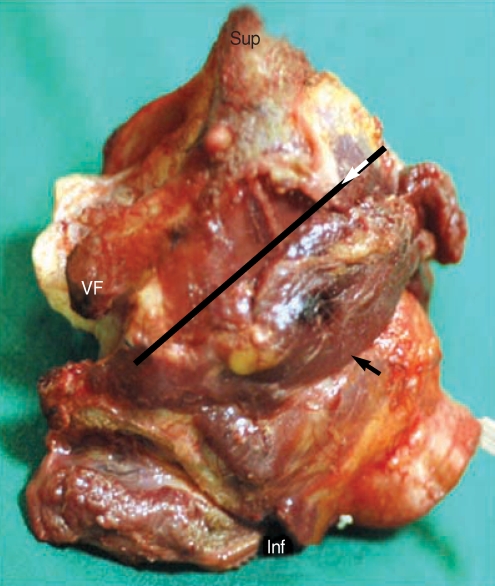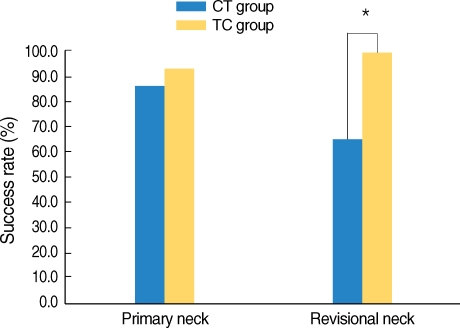Clin Exp Otorhinolaryngol.
2010 Mar;3(1):37-41.
Comparative Analysis of Efficiency of Injection Laryngoplasty Technique for with or without Neck Treatment Patients: A Transcartilaginous Approach Versus the Cricothyroid Approach
- Affiliations
-
- 1Department of Otolaryngology-Head and Neck Surgery, Soonchunhyang University College of Medicine, Bucheon, Korea.
- 2Department of Radiology, Ewha Womans University School of Medicine, Seoul, Korea.
- 3Department of Otolaryngology-Head and Neck Surgery, Samsung Medical Center, Sungkyunkwan University School of Medicine, Seoul, Korea. yison@skku.edu
Abstract
OBJECTIVES
These days, the main injection laryngoplasty technique is cricothyroid (CT) approach. However, patients who have previously undergone other neck treatments, such as thyroidectomy or neck dissection have distorted anatomical landmark makes this approach more difficult. The aim of this study is to determined the efficiency of transcartilaginous (TC) approah as compared with CT approach for unilateral vocal fold paralysis patients, especially for previously neck treated patients.
METHODS
From March 2005 to February 2008, 137 consecutive injection laryngoplasties were performed in patients with unilateral glottic insufficiency. Percutaneous injection was performed under local anesthesia into the vocalis muscle, using disposable 25 G 4 cm long needles through the cricothyroid membrane or directly through the thyroid cartilage. Of the 137 patients, 124 completed acoustic, perceptual, stroboscopic, and subjective evaluations prior to the injection and at 3 months after the injection.
RESULTS
In the 124 patients, the CT and TC approaches were used in 94 and 30 patients, respectively. Acoustic and perceptual parameters (GRBAS, MPT, jitter, shimmer), voice handicap index, and grades of mucosal waves and glottic closure were significantly improved after the injection in both the CT and TC groups (P<0.05). Only two patients (6.6%) had penetration difficulties, because of ossification of the thyroid cartilage. The overall success rates of the CT and TC approaches were 86.2%, 93.3%, respectively. However, the success rate of the TC approach in patients who had previously undergone neck treatments was significantly higher than that of the CT approach (100% vs. 65% P<0.05).
CONCLUSION
Based on the preliminary results of this trial, injection laryngoplasty using a TC approach was an effective alternative to the CT approach, especially in patients who had previously undergone neck surgeries.
MeSH Terms
Figure
Reference
-
1. Kwon TK, Buckmire R. Injection laryngoplasty for management of unilateral vocal fold paralysis. Curr Opin Otolaryngol Head Neck Surg. 2004; 12. 12(6):538–542. PMID: 15548914.
Article2. Dursun G, Boynukalin S, Ozgursoy OB, Coruh I. Long-term results of different treatment modalities for glottic insufficiency. Am J Otolaryngol. 2008; Jan–Feb. 29(1):7–12. PMID: 18061825.
Article3. Trask DK, Shellenberger DL, Hoffman HT. Transnasal, endoscopic vocal fold augmentation. Laryngoscope. 2005; 12. 115(12):2262–2265. PMID: 16369177.
Article4. O'Leary MA, Grillone GA. Injection laryngoplasty. Otolaryngol Clin North Am. 2006; 2. 39(1):43–54. PMID: 16469654.5. Lee SW, Son YI, Kim CH, Lee JY, Kim SC, Koh YW. Voice outcomes of polyacrylamide hydrogel injection laryngoplasty. Laryngoscope. 2007; 10. 117(10):1871–1875. PMID: 17690620.
Article6. Jin SM, Park CY, Lee JK, Ban JH, Lee SH, Lee KC. Transcutaneous injection laryngoplasty through the cricothyroid space in the sitting position: anatomical information and technique. Eur Arch Otorhinolaryngol. 2008; 3. 265(3):313–319. PMID: 17899146.
Article7. Berke GS, Gerratt B, Kreiman J, Jackson K. Treatment of Parkinson hypophonia with percutaneous collagen augmentation. Laryngoscope. 1999; 8. 109(8):1295–1299. PMID: 10443836.
Article8. Rosen CA, Murry T. Voice handicap index in singers. J Voice. 2000; 9. 14(3):370–377. PMID: 11021504.
Article9. King JM, Simpson CB. Modern injection augmentation for glottic insufficiency. Curr Opin Otolaryngol Head Neck Surg. 2007; 6. 15(3):153–158. PMID: 17483682.
Article10. Lee SH, Kwon HJ, Choi HJ, Lee NH, Lee SJ, Jin SM. The singer's formant and speaker's ring resonance: a long-term average spectrum analysis. Clin Exp Otorhinolaryngol. 2008; 6. 1(2):92–96. PMID: 19434279.
Article
- Full Text Links
- Actions
-
Cited
- CITED
-
- Close
- Share
- Similar articles
-
- Technical Review of How to Determine the Exact Location of Needle Tip During Office-Based Injection Augmentation of the Vocal Folds Via Cricothyroid Approach
- Vocal Fold Augmentation: Current Review
- Review of Injection Laryngoplasty as Treatment of Voice Disorders
- A Case of Neurilemmoma of the Larynx Excised via Trans-Cricothyroid Membrane Approach without Tracheostomy
- Injection Laryngoplasty



